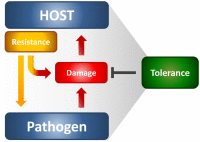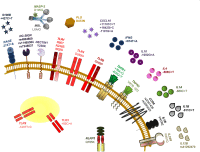Immunity and tolerance to fungi in hematopoietic transplantation: principles and perspectives
- PMID: 22707953
- PMCID: PMC3374351
- DOI: 10.3389/fimmu.2012.00156
Immunity and tolerance to fungi in hematopoietic transplantation: principles and perspectives
Abstract
Resistance and tolerance are two complementary host defense mechanisms that increase fitness in response to low-virulence fungi. Resistance is meant to reduce pathogen burden during infection through innate and adaptive immune mechanisms, whereas tolerance mitigates the substantial cost of resistance to host fitness through a multitude of anti-inflammatory mechanisms, including immunological tolerance. In experimental fungal infections, both defense mechanisms are activated through the delicate equilibrium between Th1/Th17 cells, which provide antifungal resistance, and regulatory T cells limiting the consequences of the ensuing inflammatory pathology. Indoleamine 2,3-dioxygenase (IDO), a rate-limiting enzyme in the tryptophan catabolism, plays a key role in induction of tolerance against fungi. Both hematopoietic and non-hematopoietic compartments contribute to the resistance/tolerance balance against Aspergillus fumigatus via the involvement of selected innate receptors converging on IDO. Several genetic polymorphisms in pattern recognition receptors influence resistance and tolerance to fungal infections in human hematopoietic transplantation. Thus, tolerance mechanisms may be exploited for novel diagnostics and therapeutics against fungal infections and diseases.
Keywords: IDO; fungal infections; resistance; single nucleotide polymorphism; tolerance.
Figures


Similar articles
-
Non-hematopoietic cells contribute to protective tolerance to Aspergillus fumigatus via a TRIF pathway converging on IDO.Cell Mol Immunol. 2010 Nov;7(6):459-70. doi: 10.1038/cmi.2010.43. Epub 2010 Sep 13. Cell Mol Immunol. 2010. PMID: 20835271 Free PMC article.
-
Immunity and tolerance to infections in experimental hematopoietic transplantation.Best Pract Res Clin Haematol. 2011 Sep;24(3):435-42. doi: 10.1016/j.beha.2011.04.006. Epub 2011 Jul 1. Best Pract Res Clin Haematol. 2011. PMID: 21925096 Review.
-
Immune regulation and tolerance to fungi in the lungs and skin.Chem Immunol Allergy. 2008;94:124-137. doi: 10.1159/000154957. Chem Immunol Allergy. 2008. PMID: 18802343 Review.
-
Indoleamine 2,3-dioxygenase (IDO) in inflammation and allergy to Aspergillus.Med Mycol. 2009;47 Suppl 1:S154-61. doi: 10.1080/13693780802139867. Epub 2008 Jun 4. Med Mycol. 2009. PMID: 18608907 Review.
-
Disease Tolerance Mediated by Phosphorylated Indoleamine-2,3 Dioxygenase Confers Resistance to a Primary Fungal Pathogen.Front Immunol. 2017 Nov 13;8:1522. doi: 10.3389/fimmu.2017.01522. eCollection 2017. Front Immunol. 2017. PMID: 29181001 Free PMC article.
Cited by
-
IL-23 signaling prevents ferroptosis-driven renal immunopathology during candidiasis.Nat Commun. 2022 Sep 22;13(1):5545. doi: 10.1038/s41467-022-33327-4. Nat Commun. 2022. PMID: 36138043 Free PMC article.
-
Indoleamine 2,3-dioxygenase adjusts neutrophils recruitment and chemotaxis in Aspergillus fumigatus keratitis.Int J Ophthalmol. 2022 Mar 18;15(3):380-387. doi: 10.18240/ijo.2022.03.02. eCollection 2022. Int J Ophthalmol. 2022. PMID: 35310052 Free PMC article.
-
Expression of indoleamine 2,3-dioxygenase in a murine model of Aspergillus fumigatus keratitis.Int J Ophthalmol. 2016 Apr 18;9(4):491-6. doi: 10.18240/ijo.2016.04.03. eCollection 2016. Int J Ophthalmol. 2016. PMID: 27162718 Free PMC article.
-
Application of berberine-loaded albumin nanoparticles in infections of traumatic wounds.Int J Burns Trauma. 2022 Feb 15;12(1):28-34. eCollection 2022. Int J Burns Trauma. 2022. PMID: 35309105 Free PMC article.
-
Translating Tolerogenic Therapies to the Clinic - Where Do We Stand and What are the Barriers?Front Immunol. 2012 Oct 12;3:317. doi: 10.3389/fimmu.2012.00317. eCollection 2012. Front Immunol. 2012. PMID: 23091475 Free PMC article. No abstract available.
References
Grants and funding
LinkOut - more resources
Full Text Sources
Research Materials

